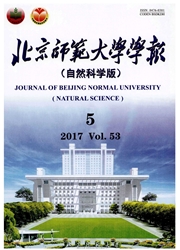

 中文摘要:
中文摘要:
研究太阳活动能量的统计分布,以探索日冕物质加热的物理机制.利用一种基于三维区域标记的算法,使用"日出"卫星拍摄的低色球层λ3968.5单色像时间序列,观测一个处于衰减阶段且爆发频繁的活动区,对多个数量级尺度的亮点进行识别和统计.获得了2.09×104个亮点样本,分析了太阳耀斑基本物理量的频数分布与幂律的关系,以及影响该分布的观测效应.数据分析的主要结果如下:1)低色球层亮点的尺度、面积、光通量服从幂律分布.2)寿命的频数在中等时标呈幂律分布,在长时标呈指数分布;大尺度亮点的等待时间符合指数分布.3)亮点发生率的信噪比随其尺度的增加而减小;小尺度亮点持续的产生有可能向日冕稳定地提供能量.4)微小尺度亮点的频数低于幂律分布,相当程度上受观测数据的低时间分辨率所造成的低采样率影响.
 英文摘要:
英文摘要:
Frequency distribution of solar energy in the low-chromosphere was investigated in the present work, mechanisms for heating solar corona was probed. Time series of λ 3968. 5 filtergrams acquired by the Hinode observatory was used, a delaying active region was observed and a sample of 2.09 × 10^4 bright points (BP) was analyzed. A feature recognition algorithm based on 3-dimensional region-labeling was developed for the identification of BP. Frequency distribution of BP size, area, and light flux virtually was found to observe the power-law. Frequency of BP lifetime is piecewise. The middle section conforms to power-law while the high end is exponential. Distribution of large BP waiting time is exponential. The signal-to-noise ratio of BP production is inversely proportional to BP size. Small-size BP could be a stable source of energy for heating corona. Small-size BP density is lower than expected by power-law, probably due to decreased sampling rate in the time series.
 同期刊论文项目
同期刊论文项目
 同项目期刊论文
同项目期刊论文
 Observations of al arge-scale gravity wave propagating over an extremely large horizontal distance i
Observations of al arge-scale gravity wave propagating over an extremely large horizontal distance i Tracking Back the Solar Wind to Its Photospheric Footpoints from Wind Observations - A Statistical S
Tracking Back the Solar Wind to Its Photospheric Footpoints from Wind Observations - A Statistical S Effects of the Scatter in Sunspot Group Tilt Angles on the Large-scale Magnetic Field at the Solar S
Effects of the Scatter in Sunspot Group Tilt Angles on the Large-scale Magnetic Field at the Solar S Effects of Alfvén Waves on Electron Cyclotron Maser Emission in Coronal Loops and Solar Type I Radio
Effects of Alfvén Waves on Electron Cyclotron Maser Emission in Coronal Loops and Solar Type I Radio Observations of a Quasi-Periodic Fast Propagating Magnetosonic Wave in Multi-Wavelength and Its Inte
Observations of a Quasi-Periodic Fast Propagating Magnetosonic Wave in Multi-Wavelength and Its Inte Coronal Heating By the Interaction between Emerging Active Regions and the Quiet Sun Observed By the
Coronal Heating By the Interaction between Emerging Active Regions and the Quiet Sun Observed By the Improved magnetogram calibration of Solar Magnetic Field Telescope and its comparison with the Helio
Improved magnetogram calibration of Solar Magnetic Field Telescope and its comparison with the Helio The dependence of flares on the magnetic classification of the source regions in solar cycles 22-23,
The dependence of flares on the magnetic classification of the source regions in solar cycles 22-23, Periodicity of the solar radius revisited by using empirical mode decomposition and the Lomb–Scargle
Periodicity of the solar radius revisited by using empirical mode decomposition and the Lomb–Scargle Dark Ribbons Propagating and Sweeping across Extreme Ultraviolet Structures after Filament Eruptions
Dark Ribbons Propagating and Sweeping across Extreme Ultraviolet Structures after Filament Eruptions The Relationship between the Particle Injection Rate and the Dispersion of the Scattering Angular Di
The Relationship between the Particle Injection Rate and the Dispersion of the Scattering Angular Di Magnetic Reconnection: From “Open” Extreme-ultraviolet Loops to Closed Post-flare Ones Observed by S
Magnetic Reconnection: From “Open” Extreme-ultraviolet Loops to Closed Post-flare Ones Observed by S Dynamics of Flare Processes and Variety of the Fine Structure of Solar Radio Emission over a Wide Fr
Dynamics of Flare Processes and Variety of the Fine Structure of Solar Radio Emission over a Wide Fr Some tests and improvements to the VFISV: Very Fast Inversion of the Stokes Vector for the Helioseis
Some tests and improvements to the VFISV: Very Fast Inversion of the Stokes Vector for the Helioseis Multi-channel observations of plasma outflows and the associated small-scale magnetic field cancella
Multi-channel observations of plasma outflows and the associated small-scale magnetic field cancella Well-observed Dynamics of Flaring and Peripheral Coronal Magnetic Loops during an M-class Limb Flare
Well-observed Dynamics of Flaring and Peripheral Coronal Magnetic Loops during an M-class Limb Flare Relationship between extreme ultraviolet microflares and small-scale magnetic fields in the quiet Su
Relationship between extreme ultraviolet microflares and small-scale magnetic fields in the quiet Su Quasi-periodic Slipping Magnetic Reconnection During an X-class Solar Flare Observed by the Solar Dy
Quasi-periodic Slipping Magnetic Reconnection During an X-class Solar Flare Observed by the Solar Dy Evolution of Relative Magnetic Helicity: Method of Computation and Its Application to a Simulated So
Evolution of Relative Magnetic Helicity: Method of Computation and Its Application to a Simulated So Three-Dimensional Nonlinear Force-Free Field Reconstruction of Solar Active Region 11158 by Direct B
Three-Dimensional Nonlinear Force-Free Field Reconstruction of Solar Active Region 11158 by Direct B Forced Field Extrapolation: Testing a Magnetohydrodynamic (MHD) Relaxation Method with a Flux-rope E
Forced Field Extrapolation: Testing a Magnetohydrodynamic (MHD) Relaxation Method with a Flux-rope E Effects of the Non-Radial Magnetic Field on Measuring Magnetic Helicity Transport across the Solar P
Effects of the Non-Radial Magnetic Field on Measuring Magnetic Helicity Transport across the Solar P The contracting and unshearing motion of flare loops in the X7.1 flare on 2005, January 20 during it
The contracting and unshearing motion of flare loops in the X7.1 flare on 2005, January 20 during it 期刊信息
期刊信息
